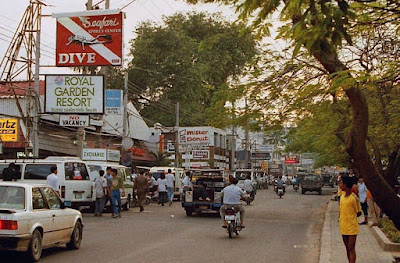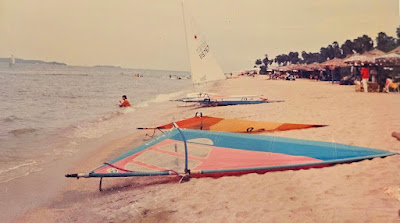The evolution of Pattaya City through old images.
Before it became the cosmopolitan hub we know today, Pattaya was a quiet fishing village. This article takes you on a nostalgic journey through the old images of Pattaya City, showcasing key moments and places from the past that have shaped its present. From the serene beaches of the 1950s to the lively streets of the 1980s, let's explore the rich history of Pattaya through twelve significant snapshots.
View Pattaya Beach in 1982.
In 1982, Pattaya Beach was a serene and picturesque stretch of sand, far less crowded than it is today. The beachfront was lined with small, locally owned businesses and a handful of resorts. Palm trees swayed gently in the sea breeze, providing a tropical canopy for visitors seeking refuge from the sun. The turquoise waters lapped softly against the shore, offering a tranquil escape for both locals and tourists.
During this time, the beach was a haven for those looking to unwind in a relatively untouched environment. The water was clear, and the sand was pristine, making it an ideal spot for sunbathing and swimming. Unlike the highly commercialized beachfront of today, Pattaya Beach in 1982 had a laid back charm that appealed to travelers seeking a simple, yet beautiful, seaside experience.
Walking Street Pattaya 1984.
Walking Street, the heart of Pattaya's nightlife, has always been a bustling hub of activity. In 1984, it was a much simpler, less extravagant version of its current self. The neon lights and vibrant signs that now characterize Walking Street were just beginning to take shape. Small bars, seafood restaurants, and local shops dotted the street, offering a variety of experiences for the adventurous tourist.
The atmosphere was lively but not as overwhelming as today. Street performers, live music, and local vendors added to the colorful ambiance, attracting visitors from all over the world. Walking Street in 1984 was a melting pot of cultures, with tourists mingling with locals, creating a unique and dynamic environment. It was a place where people could experience the authentic nightlife of Pattaya before it transformed into the entertainment juggernaut it is now.
Tony's Disco Walking Street in 2000.
By the year 2000, Tony's Disco had become one of the most iconic nightlife venues on Walking Street. Established in the late 1990s, Tony's quickly gained a reputation for its vibrant atmosphere, eclectic music, and lively crowd. The disco was a favorite among locals and tourists alike, offering a place to dance the night away in an electrifying setting.
The interior of Tony's Disco was adorned with disco balls, colorful lights, and state of the art sound systems, creating an immersive experience for party goers. The music ranged from classic disco hits to contemporary pop and dance tracks, catering to a wide audience. Tony's Disco was not just a nightclub; it was a symbol of the burgeoning nightlife scene in Pattaya, marking a new era of entertainment and excitement in the city.
Pattaya's Simon Cabaret Show in Year 85-86.
The Simon Cabaret Show, which started in the mid-1980s, quickly became one of Pattaya's most famous attractions. The cabaret showcased a dazzling array of performances, featuring talented dancers, singers, and drag performers in elaborate costumes. The show was a celebration of diversity and talent, offering a unique blend of traditional Thai culture and contemporary entertainment.
In 1985-86, the Simon Cabaret was still in its early stages, but it had already captivated audiences with its extravagant productions. The performers, known for their charisma and artistry, brought to life a variety of acts that ranged from traditional Thai dances to modern pop performances. The Simon Cabaret Show was a trailblazer in Pattaya's entertainment scene, setting the stage for the city's reputation as a hub for vibrant and diverse performances.
Siam Art Shop Next to Mike Department Store in Pattaya, 1982.
In 1982, the Siam Art Shop, located next to the iconic Mike Department Store, was a small yet significant cultural spot in Pattaya. The shop offered a variety of traditional Thai handicrafts, paintings, and souvenirs, making it a popular destination for tourists looking to take a piece of Thailand home with them. The Mike Department Store itself was one of the few large shopping centers in the city at the time, offering a range of goods from clothing to electronics.
The Siam Art Shop was more than just a place to buy souvenirs; it was a cultural hub where visitors could learn about Thai art and craftsmanship. The shop's collection included intricately carved wooden statues, delicate silk garments, and beautiful paintings depicting scenes from Thai mythology. It was a place where the traditional and modern aspects of Thai culture converged, offering a glimpse into the rich artistic heritage of the country.
Pattaya Park in 1988.
Pattaya Park, established in the late 1980s, was a major addition to the city's list of attractions. In 1988, the park was a newly built recreational area, featuring a variety of rides, a water park, and the iconic Pattaya Park Tower. The tower, standing tall with its distinctive observation deck, offered breathtaking views of the city and the Gulf of Thailand.
The park quickly became a favorite destination for families and tourists, offering a fun filled day of activities and relaxation. The water park, with its slides and wave pool, was a major draw, especially during the hot summer months. The amusement rides, ranging from gentle carousels to thrilling roller coasters, catered to visitors of all ages. Pattaya Park was a symbol of the city's growing appeal as a family-friendly destination, offering a blend of excitement and leisure.
Pattaya Beach, Thailand in the 1950s.
Before Pattaya became a bustling tourist city, it was a quiet fishing village in the 1950s. The beach was a pristine stretch of white sand, bordered by lush greenery and crystal clear waters. The local community was small, with most of the residents relying on fishing and agriculture for their livelihood.
During this time, Pattaya Beach was untouched by modern development. There were no high rise buildings, luxury resorts, or bustling streets. The beach was a serene and tranquil place, frequented only by locals and a handful of adventurous travelers. The natural beauty of Pattaya Beach in the 1950s was breathtaking, with its unspoiled landscape offering a peaceful retreat from the hustle and bustle of city life.
Pattaya Beach Road in 1989.
By 1989, Pattaya Beach Road had transformed into a lively promenade lined with hotels, restaurants, and shops. The road, which runs parallel to the beach, became a bustling hub of activity, attracting tourists from around the world. The beachfront was now dotted with sun loungers and umbrellas, and vendors selling everything from souvenirs to street food.
The atmosphere on Pattaya Beach Road was vibrant and dynamic. The road was a popular spot for evening strolls, with visitors enjoying the sea breeze and the stunning views of the Gulf of Thailand. Street performers, local artists, and musicians added to the lively ambiance, creating a festive environment. The transformation of Pattaya Beach Road in 1989 marked a significant shift in the city's identity, as it became a premier tourist destination known for its lively atmosphere and beautiful coastline.
Pattaya Postcard 1986.
The Pattaya postcard from 1986 captures a snapshot of the city during a time of rapid change and growth. The postcard features images of the beach, the bustling streets, and some of the iconic landmarks of the time. It is a nostalgic reminder of the simpler days of Pattaya, when the city was just beginning to emerge as a major tourist destination.
The postcard showcases the beauty of Pattaya's beaches, with their golden sands and turquoise waters. It also highlights the vibrant nightlife and the unique blend of traditional and modern culture that characterized the city. For many, this postcard is a cherished memory of their visit to Pattaya, capturing the essence of the city during a transformative period in its history.
Dongtan Beach, Jomtien in the Year 86.
In 1986, Dongtan Beach in Jomtien was a peaceful and less crowded alternative to the bustling beaches of central Pattaya. Known for its calm waters and relaxed atmosphere, Dongtan Beach was a favorite among locals and tourists looking for a quieter beach experience. The beach was lined with casuarina trees, providing ample shade for visitors.
Unlike the more commercialized beaches, Dongtan Beach had a more laid back vibe. The area was dotted with small beachside restaurants and bars, offering delicious Thai cuisine and refreshing drinks. The beach was also popular for water sports, including windsurfing and jet skiing. Dongtan Beach in 1986 was a serene escape, offering a perfect blend of natural beauty and relaxed leisure.
View of South Pattaya with Old Fishing Boats, 1980.
In 1980, South Pattaya was still very much a fishing community. The coastline was dotted with traditional wooden fishing boats, known as "longtail boats," anchored along the shore. The fishermen would set out early in the morning and return with their catch, which was sold in the local markets. The sight of these boats, with their colorful flags and simple designs, was a quintessential image of Pattaya's coastal life.
The area around South Pattaya was less developed compared to other parts of the city. The shoreline was lined with small fishing huts and local eateries, offering freshly caught seafood. The lifestyle was simple, and the pace of life was slower, reflecting the traditional way of life that had been sustained for generations. The view of South Pattaya with old fishing boats in 1980 is a nostalgic reminder of the city's humble beginnings as a fishing village.
Pattaya Beach 50 Years Ago.
Fifty years ago, Pattaya Beach was a different world. The beach was a pristine paradise, untouched by the rapid development that would later transform the city. The shoreline was lined with coconut trees, and the sand was soft and white. The waters were crystal clear, teeming with marine life, making it a popular spot for snorkeling and diving.
The area around the beach was sparsely populated, with a few small guesthouses and local eateries. The local community was friendly and welcoming, with a deep connection to the sea. Fishing was a major part of life, and the day's catch was often shared among neighbors. Pattaya Beach 50 years ago was a place of natural beauty and simplicity, offering a peaceful retreat from the world.
Dongtan Beach, Som Tam Seller in 1986.
In 1986, Dongtan Beach was not only known for its beautiful scenery but also for its delicious street food. Among the local vendors, the Som Tam seller was a favorite. Som Tam, a spicy papaya salad, is a staple of Thai cuisine, known for its bold flavors and refreshing taste. The vendor would prepare the dish fresh on the spot, using a mortar and pestle to mix the ingredients.
The Som Tam seller was a familiar sight on Dongtan Beach, attracting both locals and tourists with the aroma of freshly made salad. The dish was often enjoyed with sticky rice and grilled chicken, making for a perfect beachside meal. The presence of the Som Tam seller added to the vibrant and authentic atmosphere of Dongtan Beach, offering a taste of local culture and cuisine.
The old images of Pattaya City offer a fascinating glimpse into the past, revealing how much the city has changed over the years. From its humble beginnings as a quiet fishing village to its transformation into a bustling tourist destination, Pattaya has undergone a remarkable evolution. The memories captured in these photographs remind us of a time when life was simpler, and the beauty of the natural landscape was untouched. As we look back on these moments, we can appreciate the rich history and cultural heritage of Pattaya, and how it has shaped the vibrant city we know today.
















